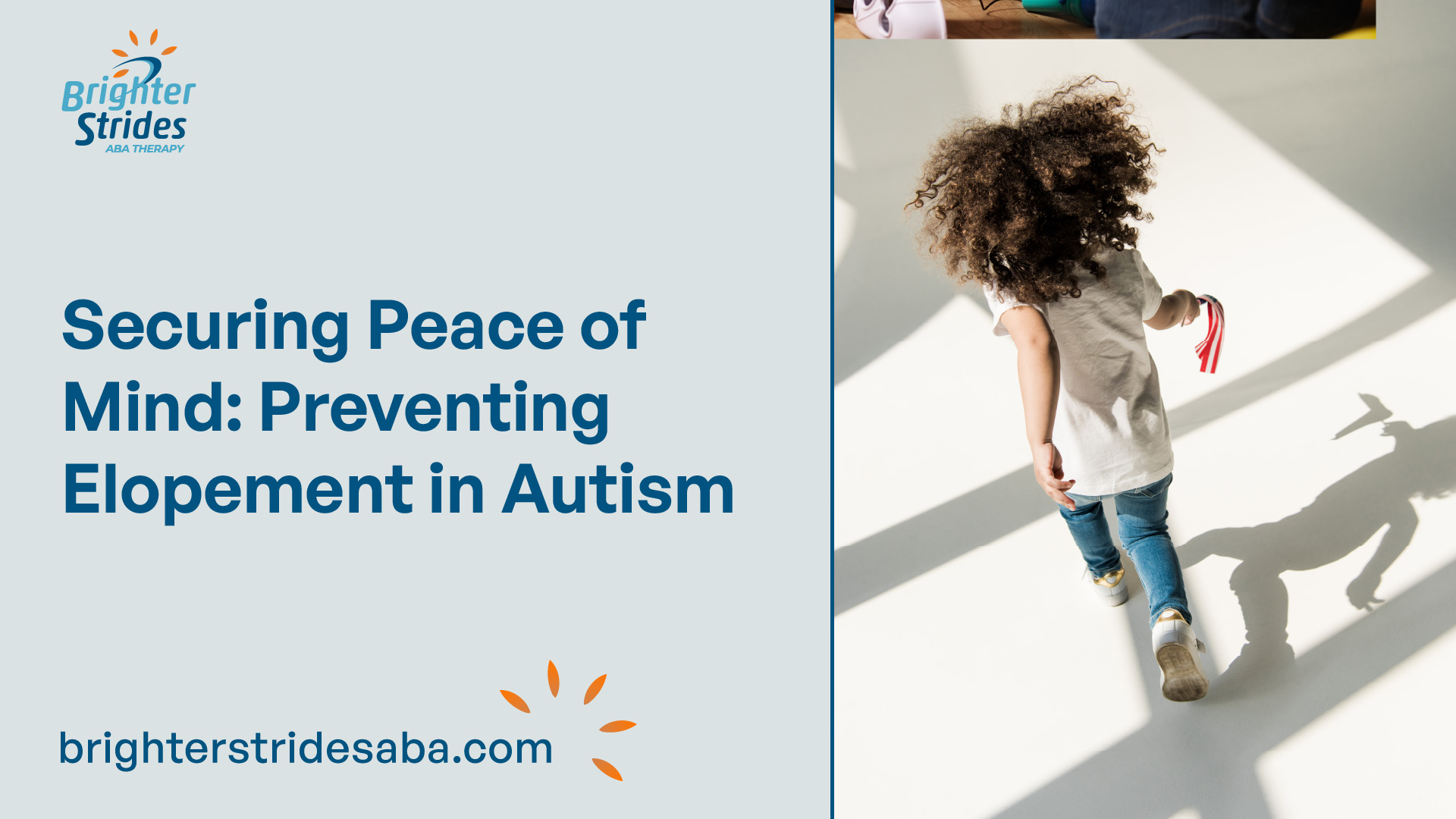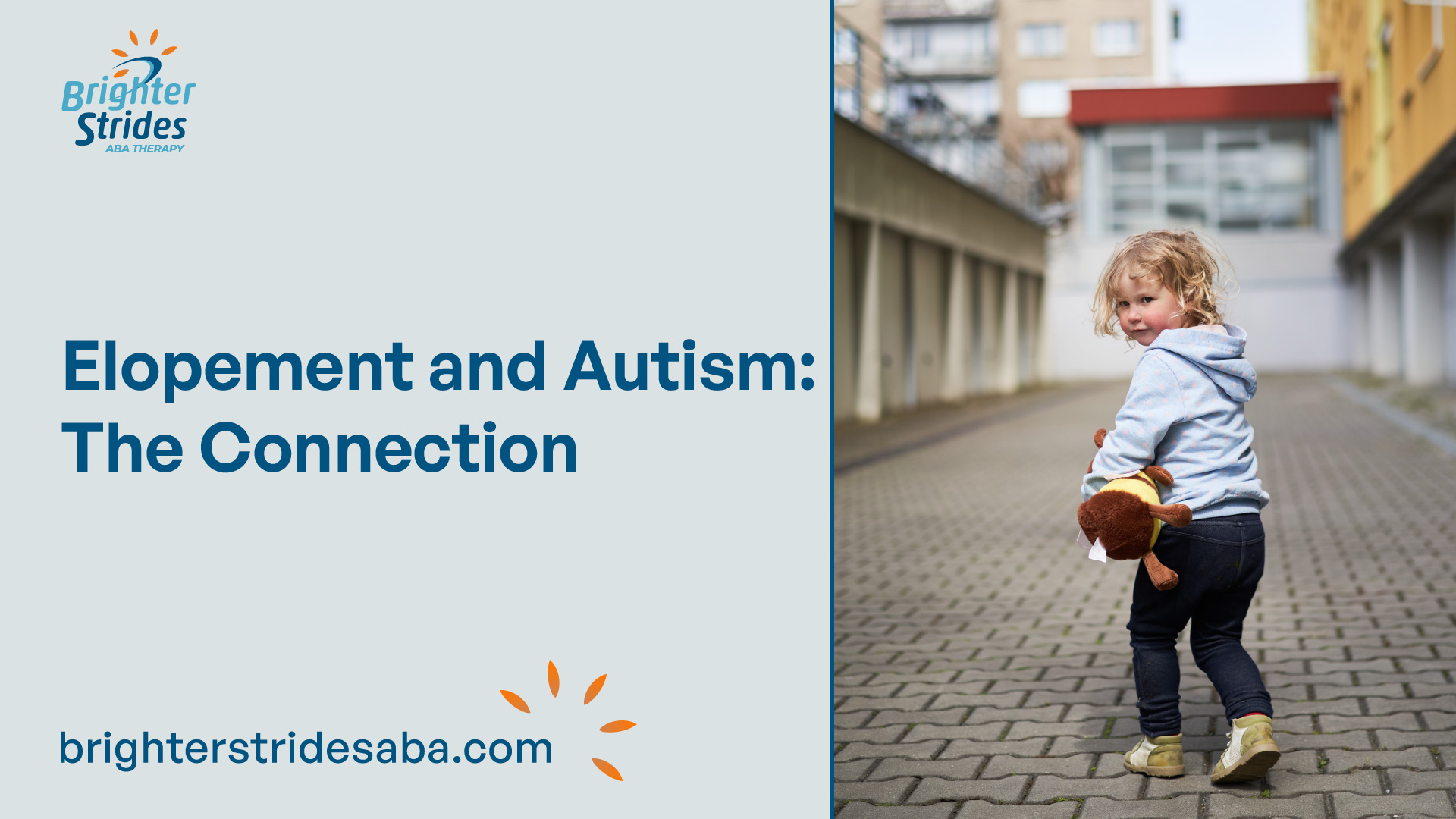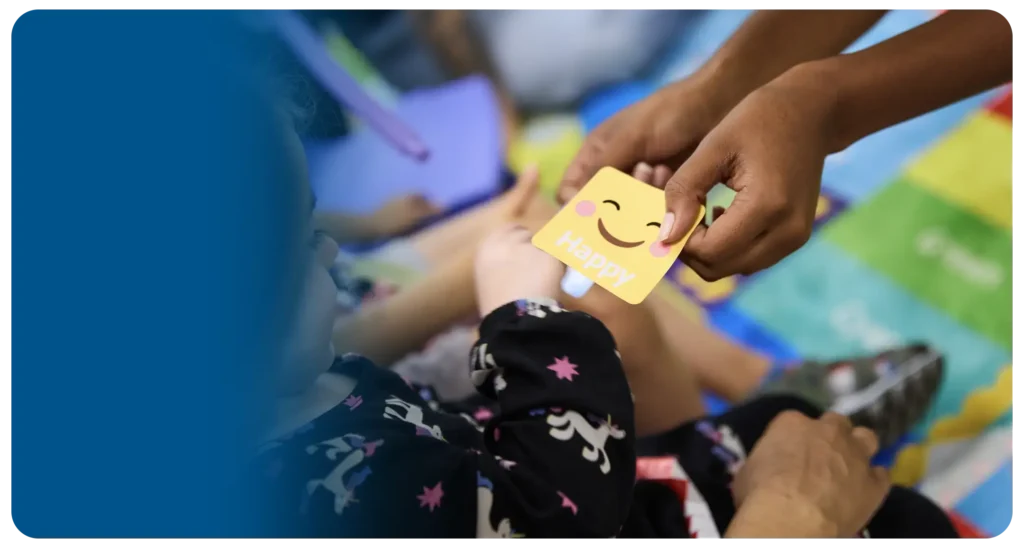Understanding Autistic Elopement
When your child suddenly heads for the door or seems drawn to leave a safe space, it can be both confusing and frightening. You might wonder if this is typical childhood curiosity or something more concerning. Let’s break down what elopement looks like, why it happens, and how you can spot the early warning signs that help keep your child safe.

What Does Eloping Mean in Autism?
Elopement happens when a child leaves an area without permission or awareness of danger. It can occur at home, school, or in public, and is more common among autistic children than their peers. Families often search for resources about autism and elopement because of the safety risks involved.
What Is Elopement Behavior in Autism?
Elopement behavior refers to the recurring pattern of leaving safe spaces without permission, rather than isolated incidents.
Your child might consistently try to leave during certain transitions, like when it’s time to go home from the playground, or run away when they feel overwhelmed by loud sounds or busy environments. Many children elope because they’re attracted to something specific, while others do it to escape situations that feel stressful or overstimulating. Recognizing these patterns helps you identify what triggers your child to elope.
What Does Eloping Look Like in Autism? What Are the Signs?
Elopement in autism can range from obvious bolting to subtle movements that happen before you realize what’s occurring.
Common examples include wandering away from a family gathering, ducking under a fence at the park, or suddenly taking off in a crowded mall. Watch for signs like repeatedly glancing at exits or becoming unusually focused on a particular door or window. Some children become very quiet and still before they bolt, while others grow restless and agitated. Learning to spot these patterns gives you extra seconds to respond.

Why Autistic Elopement Happens
Wandering makes complete sense to children in the moment, even when it seems random or dangerous to us. What drives one child to leave might be totally different from another’s motivation, and none of it reflects on your parenting.
Common Reasons Children With Autism Elope
Children elope to meet specific needs or solve problems in the only way they know how. Common triggers and situations that increase the chance of elopement include:
- Sensory overload from noise, chaos, or overwhelming environments
- Escape attempts when tasks feel impossible or boring
- Attraction to something they love, like community pools, playgrounds, or a favorite store
- Seeking sensory input, like enjoying the feeling of running
- Curiosity about what’s beyond doors without understanding the danger
- Routine changes that increase stress
Ultimately, when children wander, it’s often a response to curiosities, unmet needs, or stressors, not defiance.
At What Age Do Autistic Kids Stop Eloping?
Most autistic children don’t completely stop eloping at a specific age, but incidents typically become less frequent as they develop better communication and coping skills. For many families, the teenage years bring significant improvement as children learn to express their needs more clearly and understand safety concepts better.
However, elopement can still occur into adulthood, especially during times of high stress, sensory overload, or major life changes. The key is that consistent prevention strategies, ongoing therapy, and teaching essential safety skills typically lead to significant improvement over time.
As your child grows and changes, so will their triggers and motivations for wandering. This is why staying flexible and continuing to observe patterns in their behavior is so important.
What to Do Right Away If Your Child Elopes
When elope autism events occur, every second counts. Having a clear action plan ready beforehand can mean the difference between a quick resolution and a prolonged, dangerous situation. These steps are designed to be simple enough to follow even when your adrenaline is pumping and your mind is racing.
Call For Help and Search Water First
The moment you realize your child has eloped, call 911. Tell the dispatcher you have an autistic child who has wandered off, then provide their age, what they’re wearing, when you last saw them, and any important details, like if they’re drawn to water or don’t respond to their name.
Water should be your first search priority. While one person checks water sources, others can fan out to search different areas.
Quick Search Steps For Home, Neighborhood, and Public Spaces
At home, start with hiding spots like closets, under beds, in the garage, and the backyard. Ask your neighbors to check their yards and garages as well, since kids often hide in places that feel safe and familiar.
If you’re in public, immediately alert store employees and security guards. Ask them to watch all exits while you search inside. Most businesses will help lock down the area and make announcements.
Using ID Tags and Community Alerts in the Moment
ID bracelets, shoe tags, or labels sewn into clothing can be lifesavers. Include your phone number and “autism” or “nonverbal” if applicable. Even children who can talk might not respond when they’re scared or overwhelmed.
Before an emergency happens, share your child’s photo and information with close neighbors and local friends. When elopement occurs, you can quickly text or call this trusted network to help search. Many neighborhoods have group chats or apps like Nextdoor where you can send alerts instantly.
Keep a recent photo of your child on your phone along with a pre-written description you can copy and paste. Include height, weight, hair color, what they were wearing, and any behaviors that might help people recognize them. Having this ready saves precious minutes when you’re under stress.
How to Prevent Autism Elopement
The best way to handle elopement is to prevent it from happening in the first place. Effective prevention involves physical security, addressing your child’s sensory and emotional needs, and building communication skills.
Whether at home or in public spaces, these practical strategies can make an immediate difference while you work on longer-term solutions through ABA parent training or specialized support in daycare and school-based therapy settings.
Secure the Environment With Locks, Gates, and Alarms
Simple childproof locks on exterior doors and accessible windows are your first line of defense. Door and window alarms beep loudly the moment someone opens them, while yard fencing, especially around pools, provides another layer of protection.
Store items like house and car keys and garage door openers, where they can’t be reached or seen. Chain locks or slide bolts installed high on doors work as reliable backup security.
Reduce Sensory Overload and Meet Sensory Needs
Children with autism often wander when their senses feel overloaded, so building a calmer environment can make a big difference. Simple adjustments like using noise-canceling headphones in crowded places or setting up a quiet, low-light corner at home give them a safe retreat. You can also plan short sensory breaks throughout the day and use tools like fidgets, weighted blankets, or deep-pressure activities to help your child feel grounded before difficult transitions.
Use Visual Supports and Communication Tools
Uncertainty often fuels anxiety, which can lead to escape attempts. Visual schedules set clear expectations, while short illustrated “social stories” walk children through safety rules and everyday transitions step by step. For kids with limited speech, picture cards or AAC devices provide safer ways to say “I need help.” Even with verbal directions, pairing them with visual cues, like pointing, gestures, or brief written notes, reinforces understanding and reduces stress.
Intervention Strategies for Eloping and Autism That Work
When elopement becomes a regular pattern, targeted intervention strategies can create lasting change for your family. These approaches are grounded in research but don’t require a psychology degree to understand or implement effectively. Working with experienced ABA providers helps you develop a personalized plan that addresses the specific function behind your child’s elopement, teaching new skills while keeping everyone safe throughout the process.
Applied Behavior Analysis (ABA)
Understanding why elopement in autism happens is the first step toward stopping it. A Functional Behavior Assessment (FBA) identifies what drives a child’s elopement autism—whether it’s escaping stress, seeking something they enjoy, or trying to communicate a need. With that insight, ABA focuses on teaching safer replacement skills, like asking for a break or showing a “help” card, so children can meet their needs without running off. These new behaviors are reinforced until they become more rewarding than elopement, and they’re practiced across home, school, and community settings to ensure consistency.
Brighter Strides ABA services use comprehensive FBAs to develop tailored interventions that address each child’s specific triggers and strengths, ensuring interventions address the root causes rather than just the symptoms.
Social Stories and Visual Scripts
Social stories use short, step-by-step narratives to model safe behavior in everyday situations. For example, a story about going to the park might show how to stay with a caregiver, wait before crossing the street, and what to do if separated. Visual scripts go a step further by giving children prompts during stressful moments, like a picture sequence that says, “Feel upset → Find adult → Show help card → Wait.”
The magic happens through repetition during calm moments. Read these stories when everyone’s relaxed, not just before difficult outings. Practice the visual sequences at home when there’s no pressure or urgency. The more these become part of your family’s regular routine, the more automatically they’ll come to mind when an autism eloping event occurs.
Tracking Devices and GPS Technology
Technology can’t replace vigilant supervision but can provide crucial backup when prevention strategies fail. GPS devices designed for children come in forms that work with different tolerance levels—smartwatches for kids who don’t mind wearing them, discrete clip-ons for clothing or backpacks, and shoe inserts that stay hidden. Quality models offer waterproofing, reliable battery life, and geofencing alerts that notify you the instant someone leaves a safe zone.
Like any tool, these devices have some drawbacks to consider. Uncomfortable devices get removed, and GPS signals weaken indoors and in crowded spaces where emergencies often happen. Still, the peace of mind they provide can be invaluable during those heart-stopping moments when all other safety measures have failed. Just remember, they should enhance your existing precautions, not replace active supervision.
Building Your Safety Support Network
Elopement prevention works best when it’s a team effort, not something you handle alone. The more people in your child’s life who understand the risks and know how to respond, the safer your child becomes in every environment they enter. We’ve put together effective strategies for working with professionals, preparing family members and friends, and connecting with community resources that can strengthen your safety plan.
Partnering with Therapists, Teachers, and Caregivers
Everyone involved in your child’s care needs to be on the same page about elopement risks and response protocols. Schedule regular safety check-ins with therapists, teachers, and other caregivers to review what’s working and any changes in triggers or behaviors you’ve noticed.
Work with your child’s school team to include specific elopement protocols in their IEP or 504 plan. This should detail warning signs, immediate response steps, and emergency contacts. Beyond formal documentation, create simple written instructions that outline your child’s specific triggers and proven de-escalation techniques for everyone who spends time with them. As you learn what works and discover new patterns, share these insights with your entire care team so everyone stays current on the most effective approaches.
Training and Involving Family Members
Your extended family becomes a powerful safety network when they know what to look for and how to respond. Grandparents, siblings, and other relatives need training on recognizing warning signs during visits or outings. Walk them through the places your child gravitates toward when they elope and explain which calm responses work best in your family’s experience.
Communication keeps this network effective over time. When new patterns emerge or different strategies prove successful, update everyone who regularly spends time with your child. Give trusted relatives, babysitters, and neighbors current photos, contact information, and copies of your emergency response plan.
Finding Local Community Resources and Support Groups
Your community likely has specialized programs designed to help families manage elopement risks, though you may need to ask around to discover them. Project Lifesaver provides tracking bracelets and trained rapid response teams specifically for locating missing individuals with autism, and your local police or sheriff’s department can tell you if this program operates in your area. Many departments also maintain special needs alert registries that flag your address so first responders immediately understand they’re dealing with an autism-related emergency.
Autism support groups can become treasure troves of practical prevention strategies from parents who understand your daily challenges. These groups know which local resources work and can point you toward community programs like water safety classes or emergency preparedness training that you might not find on your own.
Staying Hopeful and Prepared
You’ve learned practical strategies that work, but having the right plan, implementing it consistently, and making adjustments over time often requires guidance from professionals familiar with autism and behavior change. When elopement remains a persistent worry, working with experienced ABA providers can transform your approach from reactive to proactive. Contact us at Brighter Strides ABA today to discuss how our team can help you create a personalized safety plan that protects your child while preserving the independence and growth opportunities they deserve.
Sources
- www.autismspeaks.org/elopement-and-wandering
- www.kennedykrieger.org/stories/preventing-elopement-tips-parents-and-caregivers
- www.nationalautismassociation.org/elopement-prevention-strategies/
- www.autismspeaks.org/applied-behavior-analysis-aba-0
- www.verywellhealth.com/gps-tracking-devices-for-autism-4178757





